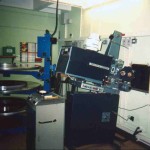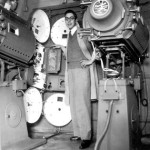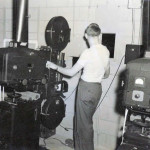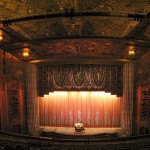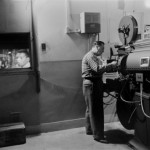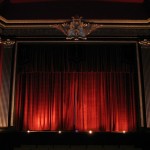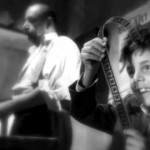The Art of the Projectionist
Guest Columnist

Introduction
The Projectionist, often conjures up a mysterious character, is about to go the way of steam train stokers and lighthouse keepers, to be released from his or her labors by computers in most cases, or a handful of specialist individuals. But once upon a time the Projectionist was seen as an important role, and in fact were often showmen in there own right. I was very pleased to be asked to write this article, on a topic which I am greatly passionate about, and which has been a large part of my life so far. However, I have to be clear from the outset that as I am only in my 30s it means that I missed out on much of the great show parts of cinema, and so I have to rely on the stories of my peers which have been told.
Early Days
Written in numerous projectionist manuals is a line to the effect “The Projectionist is the last link in the filming making chain and it is your responsibility to show that film in the best possible way.” And it was this belief and value which was instilled into the projectionist for most of the next century. Right from the very beginning showmanship and presentation was at the heart of the role for the projectionist. Once upon a time the Projectionist would be the person who would have to hand crank the film through the projector, working out the best way in which to make the projector work and to crank the machine at the proper frame rate! Often a projector and film would be bought without any instructions in the early days of cinema, when many ‘bioscopes’ where run and operated by funfair showman. These basic affairs of a tent with a few benches and a screen, got more and more ornate as the showman tried to out-do each other and persuade the audience to visit their film shows rather than a rival’s. There were big fair organs, powered by steam engines, and stage shows. All required a great deal of skill to make it happen. In the USA, it was common for small storefronts to be converted into theaters, charging five cents for a show, thus the ubiquitous name “nickelodeons.”
1920s – 1940s
Cinema presentation move into permanent buildings, often taking over existing theaters or music halls. From the mid-teens through 1940 cinemas as we know them today started to be built on a large scale, taking on the both grandeur of theaters and needs of the film industry in their architecture, and equipped with the latest projection, lighting and (late in the 20s) technology. They were palaces for the people – “Picture Palaces” or “Movie Palaces” were the names by which they were most commonly called. Often these cinemas would put on a program of film, along with live performance as well, called “cinevariety” in England or prologues in the USA. ( http://mikelangcinevariety.wordpress.com/cine-variety-memories-of-a-forgotten-era/) It was for this reason that the projectionists role also required a large number of the same techniques and traditions as live theater, including controlling the lighting, curtains and theatrical effects.
Whatever the cinema, the Projectionist was a showman and took great care with everything they did. The program would change more than once a week and each one had the same level of care and dedication given to it, with each film being rehearsed. Films would be run on more than one projector in those days and a projectionist could lose his job for missing a changeover cue and a blank screen happening as a result.
A projectionist would have to earn their way to being head projectionist by learning the requisite skills, starting as a rewind boy, spending all their time cleaning the projection room, often for many months before being allowed anywhere near any film. And it would be a long time even then before a projectionist would be allowed to even touch a projector. This extract from what is obviously a much longer documentary demonstrates very clearly the care and attention that went into the projectionist’s work: Cinema showmanship Late 40s style. In fact such was the importance and value given to the projectionist, that there was an ‘Operators Creed’ – this was not written by me, but was found in a 1935 Projectionist Diary, but is just as true today as it was then:
THE OPERATOR’S CREED
Remember yours is one of the most highly skilled jobs in this modern wonder age and technical developments succeed one another with bewildering rapidity.
Concentrated within the spool – box is the consummate artistry of playwrights, actors, producers and camera-men. You are the last and the most important link in a great chain.
According to your diligence and craftsmanship, so has this artistry, this anxious care, this enormous expense, been wasted or justified.
Yours is the task of taking thousands of your fellow men and women away from the cares of an often drab and colorless existence, transporting them on your magic carpet to a land of make-believe and sending them away refreshed to tackle the world of reality with renewed zest and high courage.
To achieve this you have to master a formidable list of highly technical subjects, you have to be resourceful in emergency, calm in danger, and unremitting in sacrificing your time and, if need be, your person in the interests of the public you serve.
A noble and inspiring calling that is surely, if slowly, receiving the recognition it deserves.
Trying to describe the perfect opening is very difficult when it is such a visual thing, and there are not many examples on the internet to demonstrate it. Many cinemas would have several sets of curtains and a set of masking, along with a variety of lights, foot lamps, stage lamps, auditorium lighting and more. Often there would by live music performed before the film. This would have been an orchestra or cinema band and later on with the cinema organ and eventually a phonograph record. The lighting would slowly fade down, as the music track – appropriately chosen for the film comes to the end and the logo of the film hits the curtains which open as the rest of the lights fade down and open up to reveal the screen. With “This is Cinerama” when the film went from the small black and white documentary of cinema history, filling the traditional 1.33:1 screen, and then the curtains opened up to reveal the huge, curved Cinerama screen, audiences gasped as they rode the Coney Island roller coaster in a way they had never before done in a cinema. Such was the power of “presentation.” http://www.youtube.com/watch?v=lII5rXbxcCs. During this period of time there could be up to five projectionists in the projection room at any one time for a show. It was all about giving the audience what we would call ‘an experience’ these days, but it was done in the same way as live theater or an opera.
The 1980s – Present
With the advent of the multiplex cinema, many projectionists lost their jobs en masse, but there was still a requirement for their skills, although there were less of them in the projection booth. By this time there was generally just one single projectionist with more and more automation to assist with screenings such as the film platter system, on which the whole film was mounted instead of doing projector changeovers for separate reels. There were still curtains to open and close and masking to be adjusted to the proper screen ratio for a specific film, as well as some lighting changes in most cinemas, so a lot of the presentation and showman skills were still required. This video from the Empire Leicester Square is of the Laser Show which use to run before the film.
However, slowly over time cinema chains have decided that it is no longer necessary to have curtains or lighting adjustments in the auditoriums, or even the masking. Audiences now walk in to a cinema with a big white blank screen, and some of the awe that had once filled them was inexorably and finally lost. with the advent of Digital Projectors it is possible for the entire presentation for a cinema circuit to be controlled by one person in a room anywhere in the world. For the majority of cinemas a single uniform presentation style began to be implemented. Only a very few independent venues still required to have a projectionist because of their desire to continue to do some theatrical presentation.
But cinema has become more complicated with all the different formats, aspect ratios, sound systems and other requirements from content makers. While the everyday films are left to low-pay non-skilled workers. These people have no sense of whether the film is being shown in the best possible way, whether all the speakers are working properly, if the lighting source lamp is aligned correctly, if the 3D filter is in its proper place – and many other questions that most of these amateur “projectionists” don’t even know to ask. This word is often delegated to concession workers, assistant managers, or anyone who just happens to be available when something needs to be done in the booth, or if heaven forbid, something goes wrong during a screening.
I am lucky that I have the chance to still get to run films with a bit of presentation – opening and closing curtains, masking and lighting – both in venues which are digital and others which are film. But all is not lost, there are still a few cinemas in the world where the art of showmanship has not disappeared completely. The El Captain Theatre in Los Angeles still puts on an amazing show, have a look at these YouTube videos.
Recently I have launched a new website entitled “We Can Still Show Film”, dedicated to capturing all the venues and projectionists who can still show film across the world as we move ever closer to a 100% digital environment. Like any technological change jobs will be lost, and in this case the projectionist is the person who find that in the majority of cases their skills, passion and knowledge will no longer be required or appreciated except in a few specialized venues.
About the author:
Peter J. Knight, otherwise known has The Mad Cornish Projectionist (www.madcornishprojectionist.co.uk), has been involved in the cinema exhibition industry since 1997, when he was started as an assistant projectionist at Flix – Loughborough Student Cinema (www.flix.org.uk). Later becoming head projectionist and actively involved with the overall running of the organization. After graduation Peter moved to London where he has freelanced as a Projectionist/AV Technican since in a variety of different venues from arts centers to preview theaters and even at the Glastonbury Music Festival. Peter is chairman of the Projected Picture Trust (www.ppttrust.org), an organization interested in the preservation of cinema technology equipment, and is also the vice-chairman of the BKSTS Cinema Technology Committee (www.bkstsctc.com), an organization which is interested in education in the current day cinema technical worker and cinema technology development. Peter also writes extensively about all areas of the cinema industry and the technical elements of projection. He has also recently just launched We Can Still Show Film (www.wecanstillshowfilm.com) a free international website which is aimed at recording all the people, venues and companies still able to handle film.

